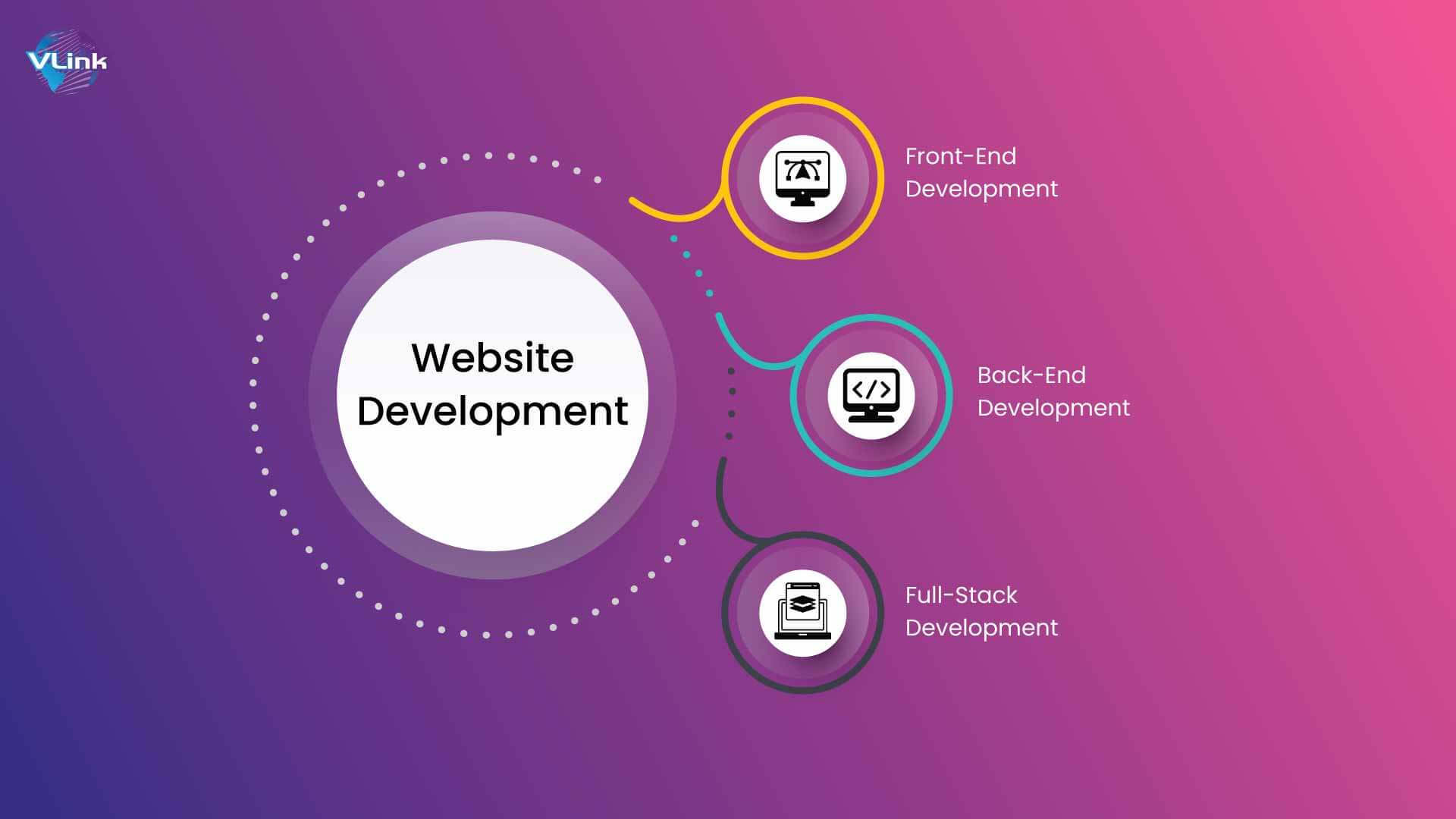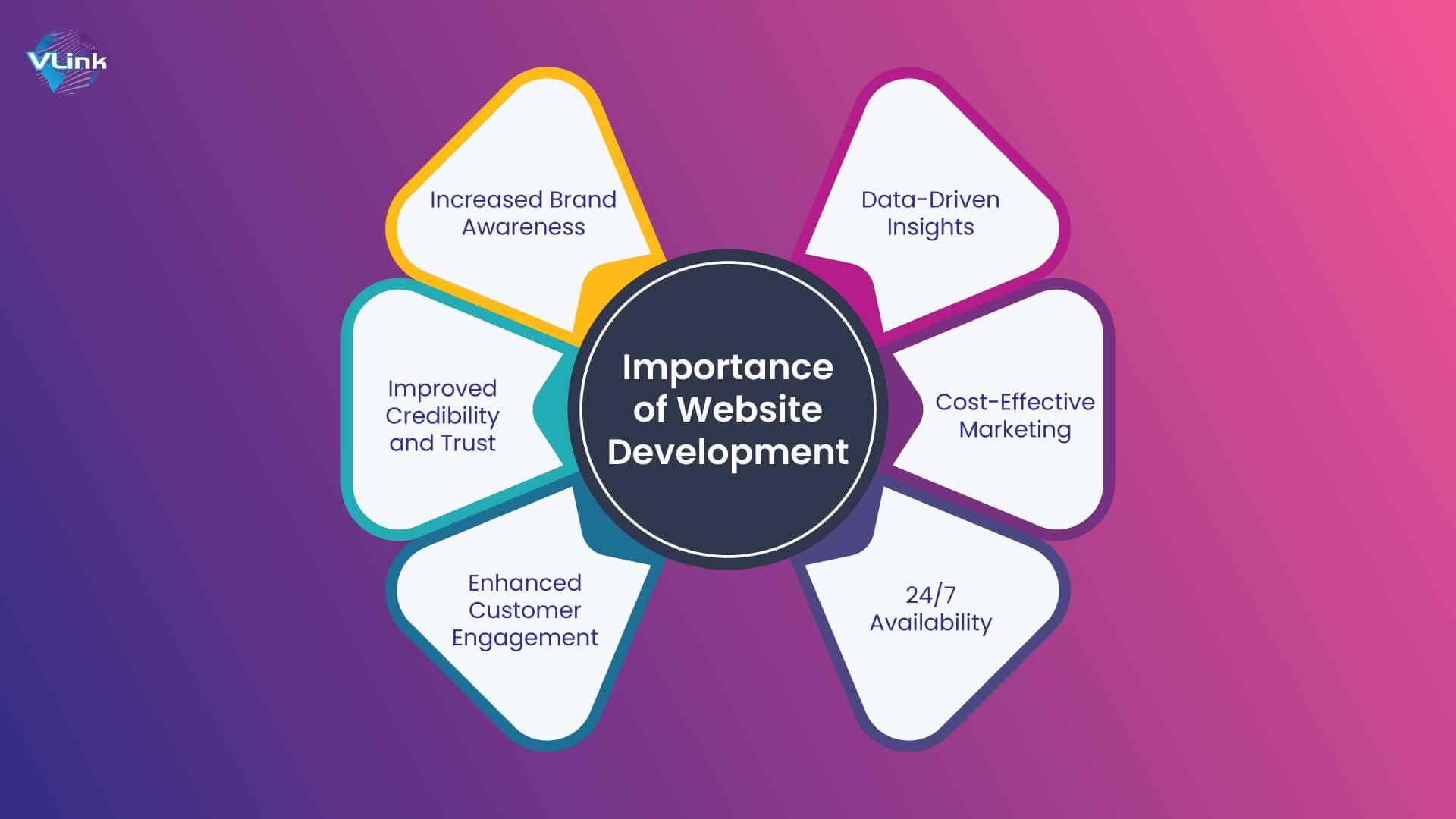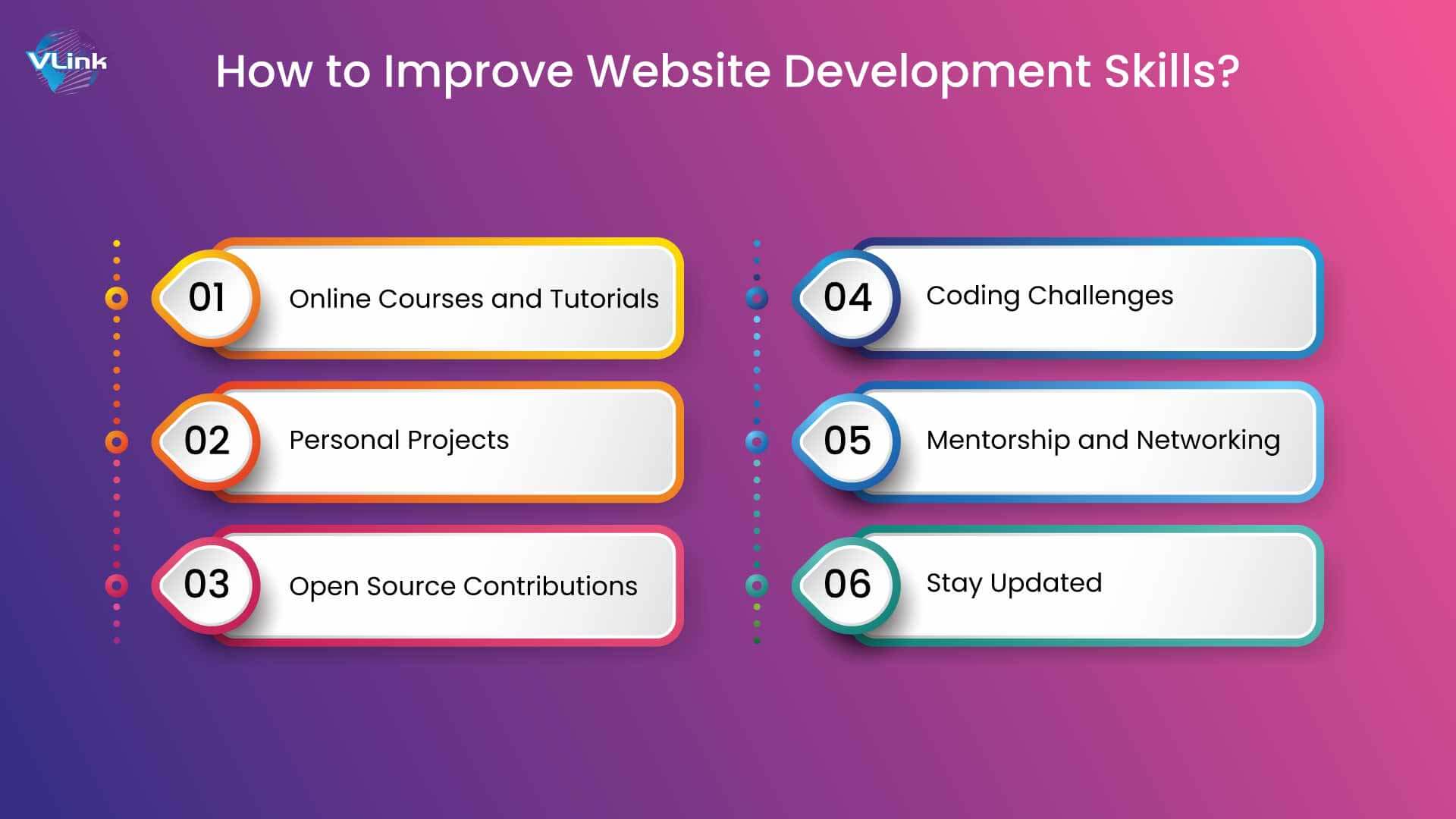The digital age has transformed the way we interact with the world. Today, having a website isn't a luxury; it's a necessity. Whether you're a budding entrepreneur, a seasoned artist, or a local club, a well-crafted website becomes your digital storefront, portfolio, or community hub.
But how do you bring this online presence to life? That's where Website Development comes in.
This comprehensive guide is designed for anyone who wants to understand the exciting world of website development. We'll break down the basics, explore different types of development, and equip you with the knowledge to navigate the website creation process.
Let's dive in!
What Is Website Development?

Website development encompasses the entire process of creating a website. It's a collaborative effort often involving designers, developers, content creators, and project managers. The website development journey starts with an idea – what do you want your website to achieve? – translates it into a visually appealing, user-friendly, and functional online space.
Think of website development as a way of building a house. The developer is the architect, laying the foundation with code. The designer is the interior decorator, crafting the visual aesthetics. Content creators are like furniture movers, filling the space with engaging content. And finally, the project manager ensures everything runs smoothly, on time, and within budget.
Types of Web Development
The world of website development is more than just a one-size-fits-all solution. There are different types, each catering to specific needs:
Front-End Development:
This focuses on the user-facing side of the website. Front-end developers are responsible for creating the visual layout, ensuring smooth navigation, and making the website interactive. Think of it as the user interface, the part you directly interact with.
Back-End Development:
Back-end developers work behind the scenes to build the website's functionalities. They manage databases, ensure secure data exchange, and create server-side scripts that power website features. This is the engine room, keeping everything running smoothly.
Full-Stack Development:
As the name suggests, hiring full-stack developers possess front-end and back-end development expertise. They wear multiple hats, handling both the user interface and the website's core functionalities.
Importance of Website Development

In today's digital landscape, a website offers a plethora of benefits for individuals and businesses alike:
- Increased Brand Awareness: A website acts as your digital billboard, allowing you to showcase your brand, products, or services to a global audience 24/7.
- Improved Credibility and Trust: A professional-looking website establishes trust and credibility with potential customers or collaborators.
- Enhanced Customer Engagement: Websites provide interactive platforms for connecting with your audience, answering their questions, and building stronger relationships.
- 24/7 Availability: Your website becomes your tireless salesperson, always open and accessible to potential customers, no matter the time zone.
- Cost-Effective Marketing: Compared to traditional marketing methods, websites offer a cost-effective way to promote your brand and reach new audiences.
- Data-Driven Insights: Websites can track user behavior and provide valuable data you can leverage to improve your offerings and marketing strategies.
Investing in website development is an investment in your digital future. It opens doors to new opportunities, strengthens your brand image, and facilitates engagement with a broader audience.
Things to Know Before Developing a Website
Before embarking on your website development journey, here are some key considerations:
- Target Audience: Who are you trying to reach with your website? Understanding your target audience is crucial for crafting relevant content and designing a user experience that resonates with them.
- Website Goals: What do you want your website to achieve? Do you want to sell products, showcase your portfolio, or build a community? Defining your goals will guide the development process and determine the features your website needs.
- Budget: Website development costs vary based on complexity, features, and chosen platform. Define a realistic budget and explore options that fit your needs.
- Domain Name and Hosting: You'll need a domain name (your website's address) and a hosting provider to store your website's files. Research different options and choose a reliable provider.
- Content Creation: Gather all the necessary content for your website, including text, images, and videos. High-quality, engaging content is essential for attracting and retaining visitors.
- Design and User Experience (UX): Consider your website's look and feel. A visually appealing and user-friendly design is crucial for a positive user experience.
- Mobile Optimization: With the increasing number of mobile users, ensure your website is responsive and looks great on different screen sizes.
- Search Engine Optimization (SEO): Optimize your website for search engines to improve visibility and attract organic traffic. Keyword research, meta descriptions, and quality content are essential elements of SEO.
What Are the 10 Stages of Website Development?
The journey from a mere concept to a fully functional website involves a meticulous process divided into distinct stages. Each step plays a crucial role in shaping the final product.

1. Planning and Research
This foundational stage involves laying the groundwork for the entire project. It encompasses:
- Defining Project Goals: Clearly outline the website's purpose, target audience, and desired outcomes.
- Competitive Analysis: Studying competitors' websites to identify strengths, weaknesses, and opportunities.
- Keyword Research: Identifying relevant keywords to optimize the website for search engines.
- Feasibility Assessment: Evaluating the project's practicality regarding resources, budget, and timeline.
2. Information Architecture
This stage focuses on structuring the website's content and navigation:
- Creating Sitemaps: Visualizing the website's structure and hierarchy.
- Information Mapping: Organizing content into logical categories and subcategories.
- User Flow Diagrams: Illustrating the user's journey through the website.
- Wireframing: Creating basic layouts to visualize the website's structure.
3. Design & Visuals
This is where the website's visual identity takes shape:
- Mood Boards: Creating visual representations of the desired aesthetic.
- Color Palette Selection: Choosing colors that align with the brand and evoke the desired emotions.
- Typography Selection: Selecting fonts that enhance readability and complement the design.
- UI/UX Design: Designing user interfaces and user experiences that are visually appealing and user-friendly.
4. Content Creation
High-quality content is essential for engaging users and achieving website goals:
- Content Strategy Development: Defining the content's purpose, tone, and style.
- Content Creation: Writing, editing, and proofreading website copy.
- Image and Media Selection: Gathering and preparing visual assets.
- SEO Optimization: Incorporating keywords and meta tags to improve search engine visibility.
5. Front-End Development
This stage involves building the website's user interface:
- HTML Structure: Creating the website's skeletal framework.
- CSS Styling: Designing the website's appearance and layout.
- JavaScript Functionality: Java Script is used to Add interactive elements and dynamic features.
- Responsive Design: Ensuring the website looks and functions well on different devices.
6. Back-End Development
The back-end focuses on the website's functionality and data management:
- Database Design: Creating databases to store website content and user information.
- Server-Side Scripting: Developing the website's logic and functionality.
- API Integration: Connecting the website to external services and data sources.
- Security Implementation: Protecting the website and user data from vulnerabilities.
7. Integration
This stage involves combining the front-end and back-end components:
- Connecting Front-End and Back-End: Integrating the user interface with the website's functionality.
- Data Synchronization: Ensuring data consistency between the front-end and back-end.
- API Testing: Verifying the correct functioning of integrated APIs.
8. Quality Assurance & Testing
Rigorous testing is crucial for identifying and fixing issues:
- Functionality Testing: Checking if all website features work as intended.
- Usability Testing: Evaluating the website's user-friendliness.
- Performance Testing: Measuring the website's speed and responsiveness.
- Compatibility Testing: Ensuring the website works across different browsers and devices.
9. Deployment
This stage involves launching the website to the live environment:
- Server Configuration: Setting up the server environment for the website.
- Domain Name Setup: Configuring the domain name to point to the website.
- Data Migration: Transferring website data from development to production.
- SSL Certificate Installation: Securing the website with HTTPS.
10. Maintenance and Updates
Ongoing maintenance is essential for keeping the website up-to-date and secure:
- Content Updates: Regularly refreshing website content.
- Security Patches: Applying updates to protect against vulnerabilities.
- Performance Optimization: Improving website speed and efficiency.
- Analytics Monitoring: Tracking website performance and user behavior.
By following these stages, you can create a well-structured, visually appealing, and functional website that meets the needs of your target audience.
Web Development Technologies and Languages
The digital landscape is constantly evolving, and so are the technologies used to build websites. Let's explore the key technologies and languages that power the web:
Front-End Development Technologies
- HTML (HyperText Markup Language): The backbone of web pages, defining the structure and content.
- CSS (Cascading Style Sheets): Styling the appearance of HTML elements, controlling layout, colors, and fonts.
- JavaScript: Adding interactivity, dynamic behavior, and user experiences to web pages.
Front-End Frameworks and Libraries
- React: A popular JavaScript library for building user interfaces.
- Angular: A comprehensive JavaScript framework for creating complex web applications.
- Vue.js: A progressive JavaScript framework known for its simplicity and flexibility.
Back-End Development Technologies
- Python: Versatile language for server-side development, often used with frameworks like Django and Flask.
- Ruby: Known for its elegance and productivity, it is often used with the Ruby on Rails framework.
- JavaScript (Node.js): Enables server-side JavaScript development, which is famous for building scalable applications.
- PHP: Widely used for web development, powering many content management systems like WordPress.
- Java: Robust language for enterprise-level web applications.
Databases
- SQL (Structured Query Language): Used for managing relational databases like MySQL, PostgreSQL, and SQL Server.
- NoSQL: Popular options include MongoDB and Cassandra for handling large volumes of unstructured data.
Other Important Technologies
- Version Control: Git is the industry standard for managing code changes.
- Cloud Platforms: AWS, Azure, and GCP offer infrastructure and services for deploying web applications.
- Content Management Systems (CMS): Platforms like WordPress, Joomla, and Drupal simplify website creation and management.
Choosing the Right Technologies
The choice of technologies depends on various factors, including:
- Project Requirements: The size, complexity, and features of the website.
- Development Team Expertise: The skills and preferences of the development team.
- Performance and Scalability: The expected website traffic and growth.
- Security Considerations: Protecting the website and user data.
- Cost and Time Constraints: Budget and project deadlines.
By understanding the vast array of web development technologies and languages, you can make informed decisions to build effective and efficient websites.
Now, let's check out the "Skills Required to Be a Web Developer."
Skills Required to Become a Web Developer
A combination of technical proficiencies and soft skills is essential to excel in web development. Let's explore the critical skills you'll need to cultivate:
Technical Skills
- Programming Languages: A strong foundation in HTML, CSS, and JavaScript is crucial for front-end development. Back-end development often requires Python, Ruby, PHP, or Java proficiency.
- Version Control: Understanding version control systems like Git is indispensable for managing code changes efficiently.
- Databases: Knowledge of SQL and database management systems is essential for handling data storage and retrieval.
- Frameworks and Libraries: Familiarity with popular frameworks and libraries like React, Angular, Node.js, and Django can significantly boost development speed and efficiency.
- Testing and Debugging: The ability to write clean, testable code and effectively troubleshoot issues is vital for delivering high-quality products.
- Responsive Design: In today's mobile-first world, creating websites that adapt to different screen sizes and devices is a fundamental skill.
- SEO Basics: Understanding search engine optimization principles can help improve website visibility and attract organic traffic.
Soft Skills
- Problem-Solving: Web development often involves tackling complex challenges, requiring analytical and problem-solving abilities.
- Communication: Effective communication with clients, team members, and stakeholders is crucial for project success.
- Creativity: Web development is both an art and a science, and creativity is essential for designing visually appealing and user-friendly interfaces.
- Attention to Detail: Precision is key in web development, as even minor errors can impact website functionality and user experience.
- Teamwork: Collaboration with designers, content creators, and other developers is often required, making teamwork essential.
- Adaptability: The web development landscape constantly evolves, so staying updated with new technologies and trends is crucial.
How to Improve Website Development Skills?

Continuous learning and practice are crucial to honing your web development skills. Here are some effective strategies:
- Online Courses and Tutorials: Platforms like Udemy and freeCodeCamp offer many courses to help you learn new technologies and improve your skills.
- Personal Projects: Build websites or web applications to gain practical experience and experiment with different approaches.
- Open Source Contributions: Contribute to open-source projects to collaborate with other developers and learn from their code.
- Coding Challenges: Participate in coding competitions to test your skills and solve real-world problems.
- Mentorship and Networking: Seek guidance from experienced developers and build a network of like-minded professionals.
- Stay Updated: Read blogs, articles, and attend conferences to stay current with the latest trends and technologies in the web development industry.
By combining these strategies with dedication and perseverance, you can significantly enhance your web development skills and build a successful career in this dynamic field.
Conclusion
Website development is a dynamic and rewarding field. You can embark on a successful career as a web developer by understanding the fundamentals, acquiring essential skills, and staying updated with industry trends. Whether you build your website in-house or outsource to a professional team, remember that a well-crafted website is valuable for any business or individual.
By following this guide and leveraging the insights provided, you're well-equipped to embark on your website development journey. Contact us today to discuss your web development needs and explore how our team can help you bring your vision to life.










 Shivisha Patel
Shivisha Patel
















